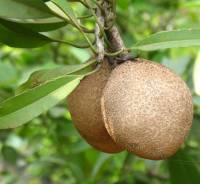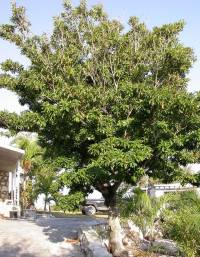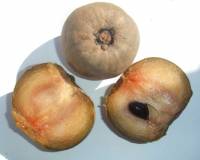Sapodilla
Botanical Information
| Botanical Information | |
|---|---|
| Order | Ericales |
| Family | Sapotaceae |
| Genus | Manilkara |
| Common Name | Sapodilla |
| Species | M. zapota |
Maturity days
Planting Months
| Planting months | |||||||||||
|---|---|---|---|---|---|---|---|---|---|---|---|
| Jan | Feb | Mar | Apr | May | Jun | Jul | Aug | Sep | Oct | Nov | Dec |
| X | X | X | X | X | X | X | X | X | X | X | X |
Permaculture uses
| Permaculture uses | ||
|---|---|---|
| Usage 1 | Usage 2 | Usage 3 |
| Food_Forest | Fruit | |
Growing condition comments
| Growing Condition | Comment |
|---|---|
| Drought Tolerant | No |
| Humidity tolerant | Yes |
| Planting area | Ground |
| Sunlight | Full_sun |
Photos
Short comments
Grows in Townsville.
General comments
Sapodilla can grow to more than 30 m tall with an average trunk diameter of 1.5 m.
It is wind-resistant and the bark is rich in a white, gummy latex called chicle. The ornamental leaves are medium green and glossy.
The fruit is a large berry, 4–8 cm in diameter. Inside, its flesh ranges from a pale yellow to an earthy brown colour with a grainy texture akin to that of a well-ripened pear. Each fruit contains one to six seeds. The seeds are hard, glossy, and black, resembling beans, with a hook at one end that can catch in the throat if swallowed. The fruit has an exceptionally sweet, malty flavour. The unripe fruit is hard to the touch and contains high amounts of saponin, which has astringent properties similar to tannin, drying out the mouth.
The trees can survive only in warm, typically tropical environments. From germination, the sapodilla tree will usually take anywhere from five to eight years to bear fruit. The sapodilla trees yield fruit twice a year, though flowering may continue year round.


